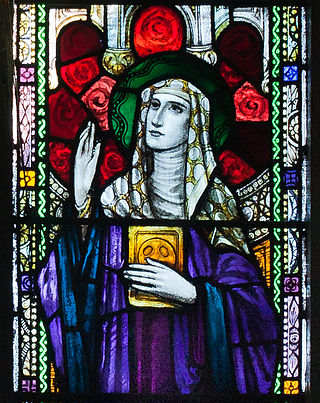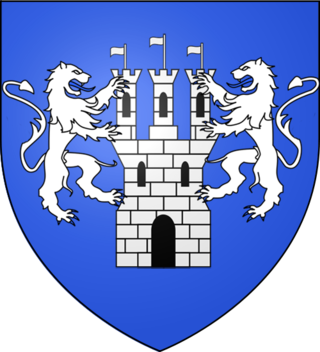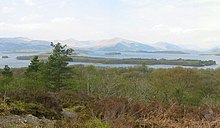
Imbolc or Imbolg, also called Saint Brigid's Day, is a Gaelic traditional festival. It marks the beginning of spring, and for Christians, it is the feast day of Saint Brigid, Ireland's patroness saint. Its traditional date is 1 February, about halfway between the winter solstice and the spring equinox. Historically, its traditions were widely observed throughout Ireland, Scotland and the Isle of Man. Imbolc is one of the four Gaelic seasonal festivals, along with: Beltane, Lughnasadh and Samhain.

Piran or Pyran, died c. 480, was a 5th-century Cornish abbot and saint, possibly of Irish origin. He is the patron saint of tin-miners, and is also generally regarded as the patron saint of Cornwall, although Michael and Petroc also have some claim to this title.

Saint Brigid of Kildare or Saint Brigid of Ireland is the patroness saint of Ireland, and one of its three national saints along with Patrick and Columba. According to medieval Irish hagiographies, she was an abbess who founded the important abbey of Kildare, as well as several other monasteries of nuns. There are few documented historical facts about her, and her hagiographies are mainly anecdotes and miracle tales, some of which are Christianisations of hero tales from Irish mythology. They say Brigid was the daughter of an Irish clan chief and an enslaved Christian woman, and was fostered in a druid's household before becoming a consecrated virgin. She is patroness of many things, including poetry, learning, healing, protection, blacksmithing, livestock and dairy production. In her honour, a perpetual fire was kept burning at Kildare for centuries.

Íte ingen Chinn Fhalad, also known as Íde, Ita, Ida or Ides, was an early Irish nun and patron saint of Killeedy. She was known as the "foster mother of the saints of Erin". The name "Ita" was conferred on her because of her saintly qualities. Her feast day is 15 January.
Saint Fillan, Filan, Phillan, Fáelán or Faolán is the name of an eighth century monk from Munster, who having studied at Taghmon Abbey, traveled to Scotland and settled at Strath Fillan.

Iarlaithe mac Loga, also known as Jarlath, was an Irish priest and scholar from Connacht, remembered as the founder of the monastic School of Tuam and of the Archdiocese of Tuam, of which he is the patron saint. No medieval biography of Jarlath is extant, but sources for his life and cult include genealogies, martyrologies, the Irish Lives of St Brendan of Clonfert, and a biography compiled by John Colgan in the 17th century.

Bega is a medieval Irish saint of Northumbria, venerated primarily in the town of St Bees. According to her Life, she was an Irish princess who fled to Northumbria to escape an arranged marriage to a Viking prince. She became an anchoress and was renowned for her piety. Multiple churches have been dedicated to her in England, and her feast day is still celebrated in St Bees.
Cellach of Armagh or Celsus or Celestinus (1080–1129) was Archbishop of Armagh and an important contributor to the reform of the Irish church in the twelfth century. He is venerated in the Roman Catholic Church as Saint Cellach. Though a member of the laicised ecclesiastical dynasty of Clann Sínaig, he took holy vows and gained priestly ordination. This put an end to the anomalous state of affairs, in effect since 966, whereby the supreme head of the Irish Church had been a layman. Following the Synod of Ráith Bressail, in which a diocesan structure for Ireland was established, he became the first metropolitan primate of all Ireland.

Saint Gobnait, also known as Gobnat or Mo Gobnat or Abigail or Deborah, is the name of an early medieval female Irish saint whose church was Móin Mór, later Bairnech, in the village of Ballyvourney, County Cork in Ireland. She is associated with the Múscraige and her church and convent lay on the borders between the Múscraige Mittine and Eóganacht Locha Léin. Her feast day is February 11.
Brannoc of Braunton or Saint Brannock was a Christian saint associated with the village of Braunton in the English county of Devon. His feast is 7 January.
Sechnassach mac Blathmaic followed his father Blathmac mac Áedo Sláine and uncle Diarmait mac Áedo Sláine as High King of Ireland and King of Brega. He belonged to the Síl nÁedo Sláine kindred of the southern Uí Néill, named for his grandfather Áed Sláine.
Cellach Cualann mac Gerthidi was the last Uí Máil king of Leinster. Cellach's byname is derived from the land of Cualu which lay around Glendalough.

Aidan of Lindisfarne was an Irish monk and missionary credited with converting the Anglo-Saxons to Christianity in Northumbria. He founded a ministry cathedral on the island of Lindisfarne, known as Lindisfarne Priory, served as its first bishop, and travelled ceaselessly throughout the countryside, spreading the gospel to both the Anglo-Saxon nobility and the socially disenfranchised.
Clan MacEacharn were a group of families who occupied lands in the Kintyre, Islay, and Morvern regions of Scotland as well as island areas such as Mull and Tiree. They are traditionally known as one of the oldest Western Highland family names. The history of the Kintyre branch and its sub branches are well known, however the histories of the Islay and Morvern branches and the island branches is obscure.
Muireann is an Irish-language feminine given name.
McCown is a Goidelic surname with several possible etymological origins.

Andrew the Apostle, also called Saint Andrew, was an apostle of Jesus. According to the New Testament, he was a fisherman and one of the Twelve Apostles chosen by Jesus. The title First-Called stems from the Gospel of John, where Andrew, initially a disciple of John the Baptist, follows Jesus and, recognizing him as the Messiah, introduces his brother Simon Peter to him.

O'Kelly is an Irish surname and the name of a number of distinct sept families in Ireland. The most prominent of these is the O'Kelly sept who were the chiefly family of the Uí Maine in Connacht. Another sept is that of the kingdom of Brega, descended from the Uí Néill. A more minor sept of O'Kelly was that descended from the Uí Máil; this sept is referred to in Irish as the Uí Ceallaig Cualann, in reference to the region of their origin, Cualu.
Mærwynn, also known as St. Merewenna or Merwinna, was a 10th-century abbess of Romsey Abbey. She is recognised as a saint in the Catholic and Eastern Orthodox churches.










